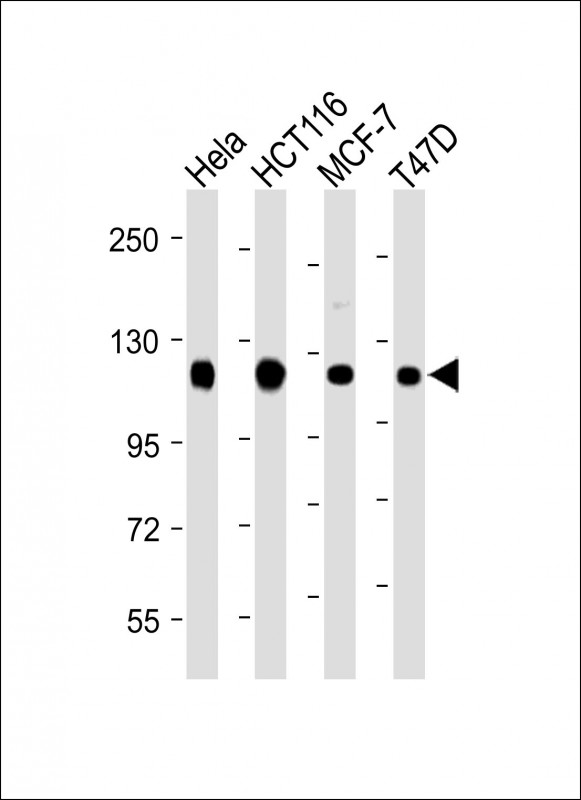RBBP8 Antibody (C-term)
Affinity Purified Rabbit Polyclonal Antibody (Pab)
- 产品详情
- 实验流程
- 背景知识
Application
| WB, E |
|---|---|
| Primary Accession | Q99708 |
| Other Accession | NP_976037.1, NP_976036.1, NP_002885.1 |
| Reactivity | Human |
| Host | Rabbit |
| Clonality | Polyclonal |
| Isotype | Rabbit IgG |
| Calculated MW | 101942 Da |
| Antigen Region | 763-792 aa |
| Gene ID | 5932 |
|---|---|
| Other Names | DNA endonuclease RBBP8, 31--, CtBP-interacting protein, CtIP, Retinoblastoma-binding protein 8, RBBP-8, Retinoblastoma-interacting protein and myosin-like, RIM, Sporulation in the absence of SPO11 protein 2 homolog, SAE2, RBBP8, CTIP |
| Target/Specificity | This RBBP8 antibody is generated from rabbits immunized with a KLH conjugated synthetic peptide between 763-792 amino acids from the C-terminal region of human RBBP8. |
| Dilution | WB~~1:2000 E~~Use at an assay dependent concentration. |
| Format | Purified polyclonal antibody supplied in PBS with 0.09% (W/V) sodium azide. This antibody is purified through a protein A column, followed by peptide affinity purification. |
| Storage | Maintain refrigerated at 2-8°C for up to 2 weeks. For long term storage store at -20°C in small aliquots to prevent freeze-thaw cycles. |
| Precautions | RBBP8 Antibody (C-term) is for research use only and not for use in diagnostic or therapeutic procedures. |
| Name | RBBP8 |
|---|---|
| Synonyms | CTIP |
| Function | Endonuclease that cooperates with the MRE11-RAD50-NBN (MRN) complex in DNA-end resection, the first step of double-strand break (DSB) repair through the homologous recombination (HR) pathway (PubMed:17965729, PubMed:19202191, PubMed:19759395, PubMed:20064462, PubMed:23273981, PubMed:26721387, PubMed:27814491, PubMed:27889449, PubMed:30787182). HR is restricted to S and G2 phases of the cell cycle and preferentially repairs DSBs resulting from replication fork collapse (PubMed:17965729, PubMed:19202191, PubMed:23273981, PubMed:27814491, PubMed:27889449, PubMed:30787182). Key determinant of DSB repair pathway choice, as it commits cells to HR by preventing classical non-homologous end-joining (NHEJ) (PubMed:19202191). Specifically promotes the endonuclease activity of the MRN complex to clear DNA ends containing protein adducts: recruited to DSBs by NBN following phosphorylation by CDK1, and promotes the endonuclease activity of MRE11 to clear protein-DNA adducts and generate clean double-strand break ends (PubMed:27814491, PubMed:27889449, PubMed:30787182, PubMed:33836577). Functions downstream of the MRN complex and ATM, promotes ATR activation and its recruitment to DSBs in the S/G2 phase facilitating the generation of ssDNA (PubMed:16581787, PubMed:17965729, PubMed:19759395, PubMed:20064462). Component of the BRCA1-RBBP8 complex that regulates CHEK1 activation and controls cell cycle G2/M checkpoints on DNA damage (PubMed:15485915, PubMed:16818604). During immunoglobulin heavy chain class-switch recombination, promotes microhomology-mediated alternative end joining (A-NHEJ) and plays an essential role in chromosomal translocations (By similarity). Binds preferentially to DNA Y-junctions and to DNA substrates with blocked ends and promotes intermolecular DNA bridging (PubMed:30601117). |
| Cellular Location | Nucleus. Chromosome Note=Associates with sites of DNA damage in S/G2 phase (PubMed:10764811, PubMed:25349192). Recruited to DSBs by the MRE11- RAD50-NBN (MRN) complex following phosphorylation by CDK1, which promotes interaction with NBN (PubMed:27814491, PubMed:27889449, PubMed:33836577). Ubiquitinated RBBP8 binds to chromatin following DNA damage (PubMed:16818604). |
| Tissue Location | Expressed in ER-positive breast cancer lines, but tends to be down-regulated ER-negative cells (at protein level) |
For Research Use Only. Not For Use In Diagnostic Procedures.
Provided below are standard protocols that you may find useful for product applications.
BACKGROUND
The protein encoded by this gene is a ubiquitously expressed nuclear protein. It is found among several proteins that bind directly to retinoblastoma protein, which regulates cell proliferation. This protein complexes with transcriptional co-repressor CTBP. It is also associated with BRCA1 and is thought to modulate the functions of BRCA1 in transcriptional regulation, DNA repair, and/or cell cycle checkpoint control. It is suggested that this gene may itself be a tumor suppressor acting in the same pathway as BRCA1. Three transcript variants encoding two different isoforms have been found for this gene. More transcript variants exist, but their full-length natures have not been determined.
REFERENCES
Kaidi, A., et al. Science 329(5997):1348-1353(2010)
Thye, T., et al. Nat. Genet. 42(9):739-741(2010)
Notaridou, M., et al. Int. J. Cancer (2010) In press :
Yasuno, K., et al. Nat. Genet. 42(5):420-425(2010)
Zhao, J., et al. BMC Med. Genet. 11, 96 (2010) :
终于等到您。ABCEPTA(百远生物)抗体产品。
点击下方“我要评价 ”按钮提交您的反馈信息,您的反馈和评价是我们最宝贵的财富之一,
我们将在1-3个工作日内处理您的反馈信息。
如有疑问,联系:0512-88856768 tech-china@abcepta.com.























 癌症的基本特征包括细胞增殖、血管生成、迁移、凋亡逃避机制和细胞永生等。找到癌症发生过程中这些通路的关键标记物和对应的抗体用于检测至关重要。
癌症的基本特征包括细胞增殖、血管生成、迁移、凋亡逃避机制和细胞永生等。找到癌症发生过程中这些通路的关键标记物和对应的抗体用于检测至关重要。 为您推荐一个泛素化位点预测神器——泛素化分析工具,可以为您的蛋白的泛素化位点作出预测和评分。
为您推荐一个泛素化位点预测神器——泛素化分析工具,可以为您的蛋白的泛素化位点作出预测和评分。 细胞自噬受体图形绘图工具为你的蛋白的细胞受体结合位点作出预测和评分,识别结合到自噬通路中的蛋白是非常重要的,便于让我们理解自噬在正常生理、病理过程中的作用,如发育、细胞分化、神经退化性疾病、压力条件下、感染和癌症。
细胞自噬受体图形绘图工具为你的蛋白的细胞受体结合位点作出预测和评分,识别结合到自噬通路中的蛋白是非常重要的,便于让我们理解自噬在正常生理、病理过程中的作用,如发育、细胞分化、神经退化性疾病、压力条件下、感染和癌症。






